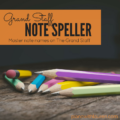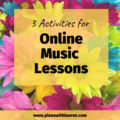This post may contain affiliate links. As a Sheet Music Plus and Amazon Associate, I earn from qualifying purchases. That means I make a small commission (at no additional cost to you) if you purchase something from an affiliate link.
I enjoy using games and activities in my piano lessons. Just try saying “Let’s play a game!” and see how your student responds.
I have about three big drawers of games at my studio. However, I don’t think you need a lot of games or supplies to be able to create activities for students. If you have just one music staff dry-erase board, you can create a lot of activities from just that one item.

The activities with a music staff dry-erase board can be tailored to the age of the student. I have found that all students enjoy drawing on the board! Younger students often feel like a teacher when they get to draw on the board. I know children love drawing on the board at school. Purchase more than one board and you will be able to do these activities in a group setting.
This particular board has both a side with staves and a side that is totally blank. I recommend you have:
- Music Staff Dry-Erase Board
- Dry-Erase Markers
- An Eraser (a paper towel or cloth works just fine too)
Here are some ideas for using your music staff dry-erase board:
#1 – Practice the Musical Alphabet
- Have the student write out The Musical Alphabet going up or down on the board.
- Draw one letter on the board, and ask the student to write a step up from that letter. Continue writing a letter on the board and ask the student to draw a step up, step down, skip up, or skip down from that letter.
#2 – Practice Drawing Notes or Symbols
- Show students how to draw line notes and space notes correctly on the staff.
- Practice drawing rests and clefs in the correct place on the staff.
- Advanced students can practice drawing quarter notes with steps up or down on the staff. Show students that stems go down starting at the third line on the staff.
- Draw a note and ask the student to add a sharp, flat, or natural to the note. Practice drawing accidentals very neatly as they should go on the staff.
#3 – Note Names
- Draw notes on either clef and ask the student to write the letter name.
- Write a letter and ask the student to draw that note on the treble and the bass clef.
- Make this activity a game by creating words for the student to name. Some words you can create with note names include: FACE, EGG, ACE, ADD, AGE, BAD, BEAD, CAGE, DAD, etc.
- Practice ledger line notes.
#4 – Intervals
- Draw a note on the staff and ask the student to draw up a second from that note. You can practice any interval by doing this and any direction.
- Draw intervals and label them. Ask the student to check your work. Students love marking things that are wrong! It’s like being the teacher.
#5 – Practice Drawing Scales or Chords
- For beginning students, write the letter names of a scale. Ask them to add any sharps or flats if needed.
- Older students can draw a scale one octave on the staff in whole notes.
- Write a letter and ask the student to draw that chord.
- Advance chord drawing by asking the student to draw root position, first inversion, or second inversion chords.
#6 – Practice Key Signatures
- Draw a key signature and ask the student to write the letter name.
- Write the name of the key and ask the student to draw the key signature.
- Do this with major or minor keys.
#7 – Rhythm Practice
- Draw a rhythm and ask the student to write the time signature.
- Draw a rhythm with a time signature but leave some measures incomplete. Ask the student to complete the measure with one note. Repeat the exercise using rests.
#8 – Fun with Terms
- Demonstrate a term on the piano. For example, play something loud. Ask the student to draw the symbol for what you are doing. A student should draw the symbol for forte.
- Make it even more fun by having the student draw their own term and tell you to demonstrate it. If the student needs help, give them a word bank to choose from.
- This can be down with dynamic symbols, articulation, or even tempo.
Did you think of something to do with your music staff dry-erase board? Feel free to leave a comment and share it with me!

Lauren teaches piano to students of all ages. She enjoys creating resources for her students and teachers. She is the author of Ready for Theory®. For personalized help, check out the consultations page for teachers.





Have 2 sets of coloured magnets
Put 1 on the white board and the student has to put the other on the correct key on the piano and vice versa.